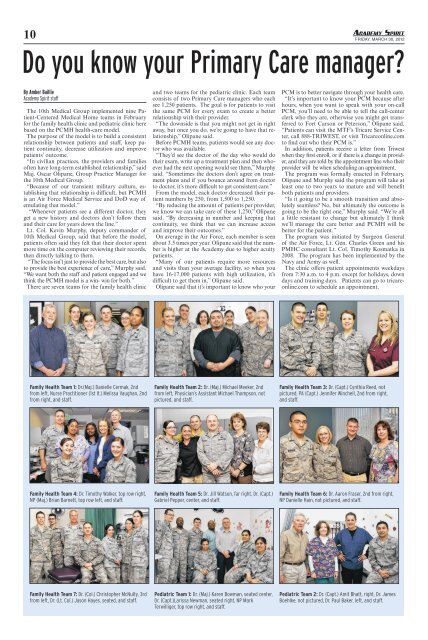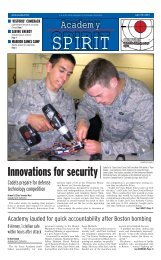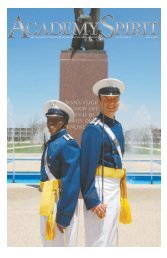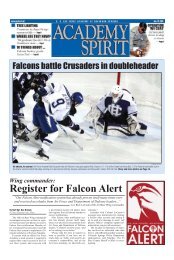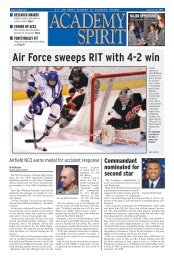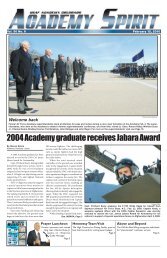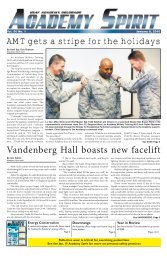Cadets trade sand and surf for nail guns and paint brushes
Cadets trade sand and surf for nail guns and paint brushes
Cadets trade sand and surf for nail guns and paint brushes
Create successful ePaper yourself
Turn your PDF publications into a flip-book with our unique Google optimized e-Paper software.
10 friDAY, mArch 30, 2012<br />
Do you know your Primary Care manager?<br />
By Amber Baillie<br />
Academy Spirit staff<br />
The 10th Medical Group implemented nine Patient-Centered<br />
Medical Home teams in February<br />
<strong>for</strong> the family health clinic <strong>and</strong> pediatric clinic here<br />
based on the PCMH health-care model.<br />
The purpose of the model is to build a consistent<br />
relationship between patients <strong>and</strong> staff, keep patient<br />
continuity, decrease utilization <strong>and</strong> improve<br />
patients’ outcome.<br />
“In civilian practices, the providers <strong>and</strong> families<br />
often have long-term established relationship,” said<br />
Maj. Oscar Olipane, Group Practice Manager <strong>for</strong><br />
the 10th Medical Group.<br />
“Because of our transient military culture, establishing<br />
that relationship is difficult, but PCMH<br />
is an Air Force Medical Service <strong>and</strong> DoD way of<br />
emulating that model.”<br />
“Whenever patients see a different doctor, they<br />
get a new history <strong>and</strong> doctors don’t follow them<br />
<strong>and</strong> their care <strong>for</strong> years down the line.”<br />
Lt. Col. Kevin Murphy, deputy comm<strong>and</strong>er of<br />
10th Medical Group, said that be<strong>for</strong>e the model,<br />
patients often said they felt that their doctor spent<br />
more time on the computer reviewing their records,<br />
then directly talking to them.<br />
“The focus isn’t just to provide the best care, but also<br />
to provide the best experience of care,” Murphy said.<br />
“We want both the staff <strong>and</strong> patient engaged <strong>and</strong> we<br />
think the PCMH model is a win- win <strong>for</strong> both.”<br />
There are seven teams <strong>for</strong> the family health clinic<br />
Family Health Team 1: Dr.(Maj.) Danielle Cermak, 2nd<br />
from left, Nurse Practitioner (1st lt.) Melissa Vaughan, 2nd<br />
from right, <strong>and</strong> staff.<br />
Family Health Team 4: Dr. Timothy Walker, top row right,<br />
NP (Maj.) Brian Barnett, top row left, <strong>and</strong> staff.<br />
Family Health Team 7: Dr. (Col.) Christopher McNulty, 3rd<br />
from left, Dr. (Lt. Col.) Jason Hayes, seated, <strong>and</strong> staff.<br />
<strong>and</strong> two teams <strong>for</strong> the pediatric clinic. Each team<br />
consists of two Primary Care managers who each<br />
see 1,250 patients. The goal is <strong>for</strong> patients to visit<br />
the same PCM <strong>for</strong> every exam to create a better<br />
relationship with their provider.<br />
“The downside is that you might not get in right<br />
away, but once you do, we’re going to have that relationship,”<br />
Olipane said.<br />
Be<strong>for</strong>e PCMH teams, patients would see any doctor<br />
who was available.<br />
“They’d see the doctor of the day who would do<br />
their exam, write up a treatment plan <strong>and</strong> then whoever<br />
had the next opening would see them,” Murphy<br />
said. “Sometimes the doctors don’t agree on treatment<br />
plans <strong>and</strong> if you bounce around from doctor<br />
to doctor, it’s more difficult to get consistent care.”<br />
From the model, each doctor decreased their patient<br />
numbers by 250, from 1,500 to 1,250.<br />
“By reducing the amount of patients per provider,<br />
we know we can take care of these 1,250,” Olipane<br />
said. “By decreasing in number <strong>and</strong> keeping that<br />
continuity, we think that we can increase access<br />
<strong>and</strong> improve their outcomes.”<br />
On average in the Air Force, each member is seen<br />
about 3.5 times per year. Olipane said that the number<br />
is higher at the Academy due to higher acuity<br />
patients.<br />
“Many of our patients require more resources<br />
<strong>and</strong> visits than your average facility, so when you<br />
have 16-17,000 patients with high utilization, it’s<br />
difficult to get them in,” Olipane said.<br />
Olipane said that it’s important to know who your<br />
Family Health Team 2: Dr. (Maj.) Michael Meeker, 2nd<br />
from left, Physician’s Assistant Michael Thompson, not<br />
pictured, <strong>and</strong> staff.<br />
Family Health Team 5: Dr. Jill Watson, far right, Dr. (Capt.)<br />
Gabriel Pepper, center, <strong>and</strong> staff.<br />
Pediatric Team 1: Dr. (Maj.) Karen Bowman, seated center,<br />
Dr. (Capt.)Larissa Newman, seated right, NP Mark<br />
Terwilliger, top row right, <strong>and</strong> staff.<br />
PCM is to better navigate through your health care.<br />
“It’s important to know your PCM because after<br />
hours, when you want to speak with your on-call<br />
PCM, you’ll need to be able to tell the call-center<br />
clerk who they are, otherwise you might get transferred<br />
to Fort Carson or Peterson,” Olipane said.<br />
“Patients can visit the MTF’s Tricare Service Center,<br />
call 888-TRIWEST, or visit Tricareonline.com<br />
to find out who their PCM is.”<br />
In addition, patients receive a letter from Triwest<br />
when they first enroll, or if there is a change in provider,<br />
<strong>and</strong> they are told by the appointment line who their<br />
provider will be when scheduling an appointment.<br />
The program was <strong>for</strong>mally enacted in February.<br />
Olipane <strong>and</strong> Murphy said the program will take at<br />
least one to two years to mature <strong>and</strong> will benefit<br />
both patients <strong>and</strong> providers.<br />
“Is it going to be a smooth transition <strong>and</strong> absolutely<br />
seamless? No, but ultimately the outcome is<br />
going to be the right one,” Murphy said. “We’re all<br />
a little resistant to change but ultimately I think<br />
we’ll manage the care better <strong>and</strong> PCMH will be<br />
better <strong>for</strong> the patient.”<br />
The program was initiated by Surgeon General<br />
of the Air Force, Lt. Gen. Charles Green <strong>and</strong> his<br />
PMHC consultant Lt. Col. Timothy Kosmatka in<br />
2008. The program has been implemented by the<br />
Navy <strong>and</strong> Army as well.<br />
The clinic offers patient appointments weekdays<br />
from 7:30 a.m. to 4 p.m. except <strong>for</strong> holidays, down<br />
days <strong>and</strong> training days. Patients can go to tricareonline.com<br />
to schedule an appointment.<br />
Family Health Team 3: Dr. (Capt.) Cynthia Reed, not<br />
pictured, PA (Capt.) Jennifer Winchell, 2nd from right,<br />
<strong>and</strong> staff.<br />
Family Health Team 6: Dr. Aaron Fraser, 2nd from right,<br />
NP Danielle Hain, not pictured, <strong>and</strong> staff.<br />
Pediatric Team 2: Dr. (Capt.) Amit Bhatt, right, Dr. James<br />
Boehlke, not pictured, Dr. Paul Baker, left, <strong>and</strong> staff.


